In my storied history with the Commander format, I’ve faced a constant struggle to name my favorite of favorite decks. For a long time Ib Halfheart, Goblin Tactician was the deck I always carried with me. Later Nekusar, the Mindrazer of all things might have been my top pick, and then there is Shattergang Brothers. I love when the Shattergang gets to come out and shine—a deck I built that is uniquely mine. But for much of my Commander career there has been an opening act, a strong second to whatever deck I have in my personal spotlight, helmed by Doran, the Siege Tower. Today I want to dive into what makes this deck a perennial favorite, and frankly, how I even discovered it.
Doran has an extremely unique effect within the game that fascinated me to no end. Upon discovering Commander, I wanted to find a deck to build around it. The issue was, Treefolk tribal was far too linear for me and nothing else really came to mind for several years. This lasted until I started employing a deck-building philosophy I will still return to today from time to time: building a deck from a different format within Commander. I have written about decks in this style before, trying to capture Caw-Blade or the Living End deck as a novelty; and my Doran deck was my first attempt, dating back to late-2013.
The idea began from a simple place. I wanted to try to make Soul Sisters exist in Commander, but knew that it could not be something feasible in mono white alone, like its Modern counterpart. I had to look at what that deck was trying to do and really figure out what drove it. At the time I don’t believe Proclamation of Rebirth and Martyr of Sands had caught on; and truthfully, the strategy of getting Soul’s Attendant and Soul Warden into play to gain incremental life is far more interesting to me anyway, especially in a multiplayer game. Very quickly I was in Green/White with a Trostani, Selesnya’s Voice deck, but wasn’t getting the results I was looking for during testing. It was a little concerning at the time. Trostani literally helped you gain life and that was the purpose of the deck; why didn’t it work?
What I discovered was that White and Green are fine, but what I really needed was a third color that played well with life. Enter Black. Having access to cards like Greed, Phyrexian Arena, and Erebos, God of the Dead meant that I could use the extra life as a resource towards card advantage. And opening my deck up to a card like Blood Artist meant that I was not only using creatures entering the battlefield, but also exiting. This was the first of many steps away from the puritanical ideal of Soul Sisters deck and a solid path to create the Doran deck I had always wanted. Over time this deck became one of the favorites due to the mana base I carefully built with increased scrutiny, the space I made for both wide and pinpoint removal, and critical eye I gave to building in alternate win conditions that proved to work well within the deck.
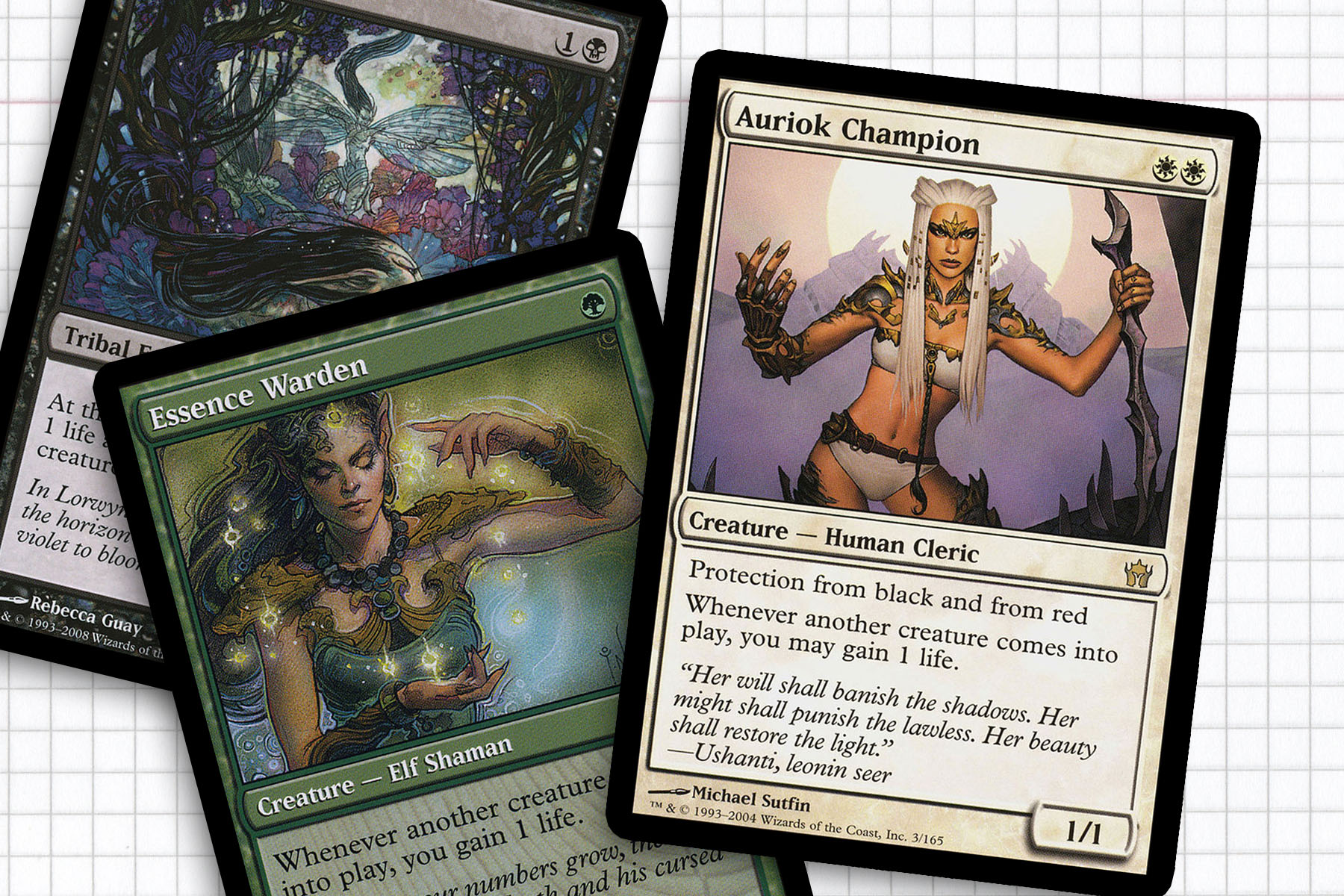
Idolizing Doran
Rewinding the clock a bit, I had an affinity for Doran, the Siege Tower from the moment I got my copy. I acquired it during a draft of Lorwyn/Lorwyn/Morningtide my friends and I did in the summer of 2010. That day was remembered fondly for being the draft where my friend Jesse mind tricked my friend Louis into passing him a Bitterblossom by simply telling him, “that’s not good in Draft” and then taking it as his next pick. I think Jesse won every game he cast the enchantment. This was my first reading of Doran because I hadn’t played Magic during our trip to Lorwyn, looking at its Welsh, Scottish, and Celtic inspired world as too childish for someone who was in college.
Looking back, it was one of a series of mistakes I’ve made in life, because I was too concerned with my hobby being considered some kind of embarrassment. Both Lorwyn and Shadowmoor blocks have become important as more and more cards from the blocks have found a place in Commander. Even beyond that, I have become more and more fond of the plane as the years have passed and really regret missing out on it, even if the complexity required the creation of New World Order within Magic R&D.
The current decklist can read like a mishmash of cards when compared to my original intentions. Over five years that intention morphed from a strategy concerning incremental life gain to a pick-your-Voltron life gain deck, valuing life gain through powerful creatures able to hold their own. I think that partially comes from my own experience with the deck and understanding what will and won’t work as new sets come out. A card like Ajani’s Welcome looks like it has a place in this deck, but because I don’t necessarily have creatures constantly flowing into play, the fact that it only triggers off of my creatures is not helpful. In fact the actual “Soul Sisters” are gone, with only Auriok Champion surviving over Soul Warden and Essence Warden, because she has upside they didn’t.
In all honesty, the deck does have a bit of the IKEA Effect brewed in—a cognitive bias in which consumers place a disproportionately high value on products they partially created. Doran does not need to be the general over legendary creatures like Anafenza, the Foremost or Ghave, Guru of Spores. But because I started with journey with the stoic treefolk, I retained too much of an attachment to later swap him out.
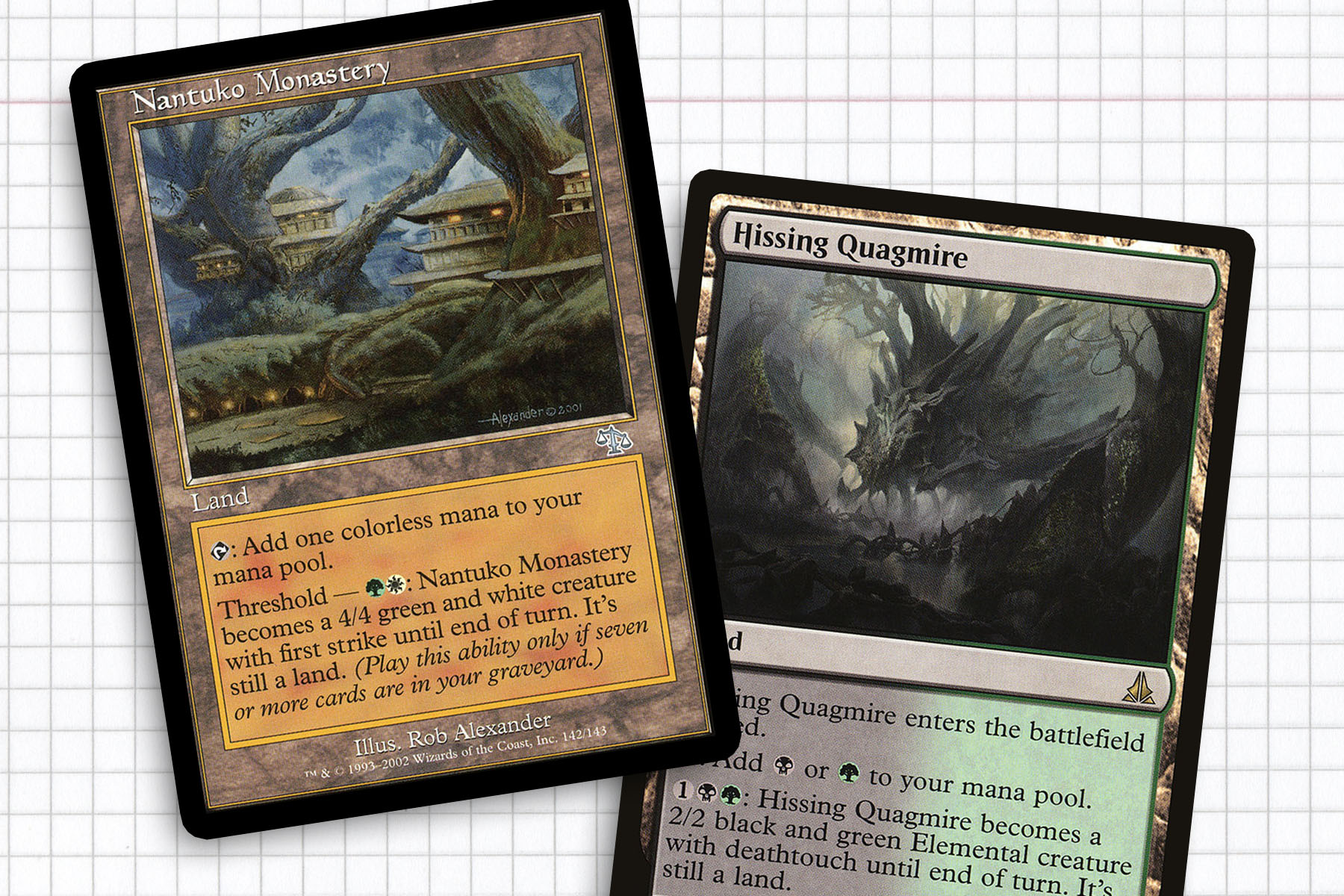
When Hills Have Eyes
The lands are one of the features of this deck that doesn’t usually come up in many of my other decks. Overall, I’ve spent more time choosing these lands than for any other deck I’ve built, with only my Shattergang Eldrazi deck being close. In this case upon looking at Stirring Wildwood and Nantuko Monastery, I decided to push further in the direction of using lands that animated themselves to help thrive as a Voltron deck that wasn’t solely dependent on the general. This would later carry over to Hissing Quagmire and Shambling Vent coming in upon their printings and eventually removing Mutavault, because I needed colored mana more than I needed a 2/2.
This was the deck where I discovered two pet cards, Nature’s Lore and Skyshroud Claim, which then made the use of the Ravnica Shocklands and Murmuring Bosk far more valuable. And the use of dual lands in a meaningful way also makes the deck run smoother in a measurable way, as I never feel like I am missing my colors.
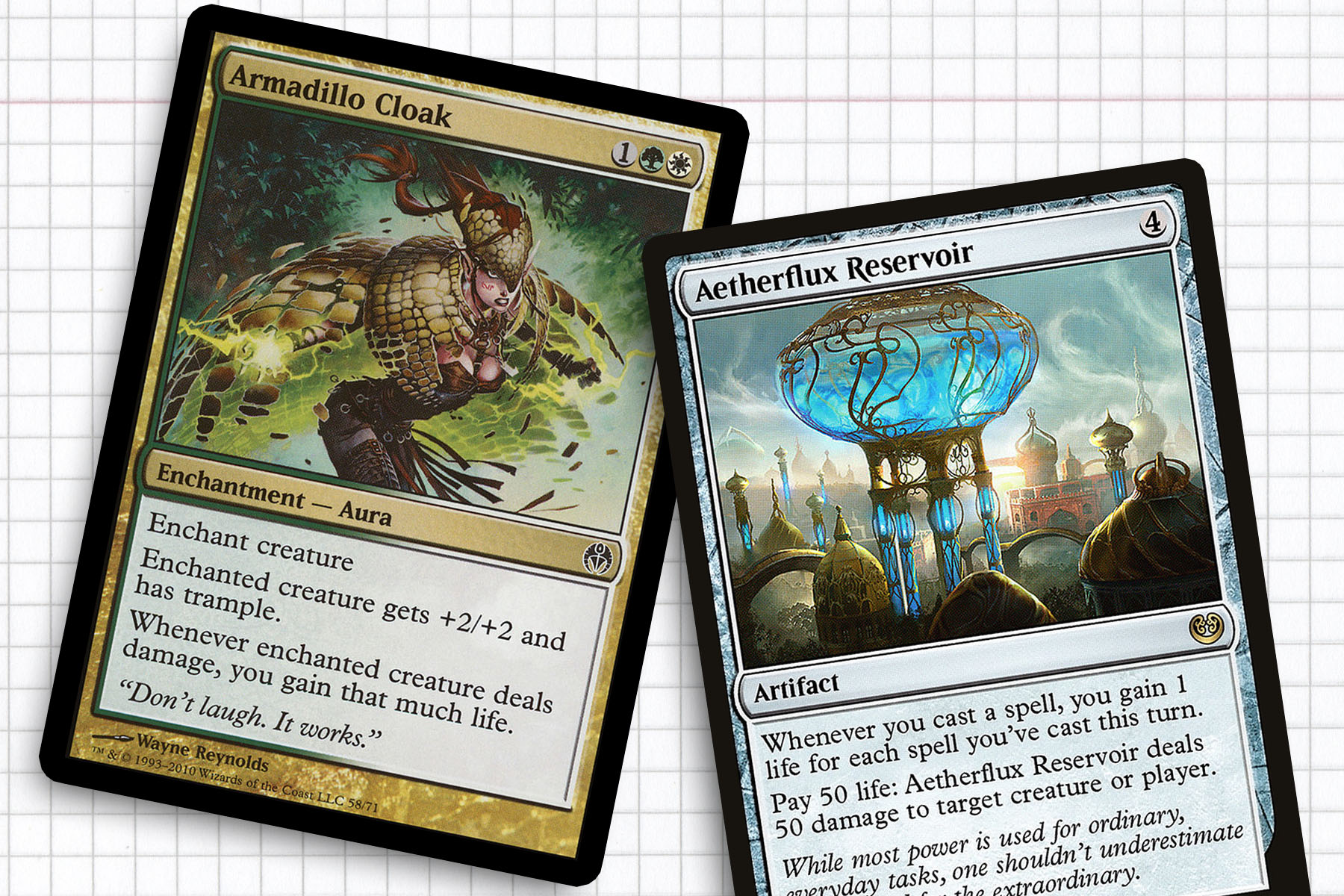
Winning with Style
For someone who has played Magic for over fifteen years, I really suck at doing combat math sometimes. This ultimately means that I don’t often get wins through combat alone, though commander damage is far easier to track. For every game where I build a commanding lead with Armadillo Cloak attached to Doran, Ageless Entity, or Ayli, Eternal Pilgrim; there are a half dozen where I need to still be in the game on turn twelve. This is important, because as Magic players, it’s good to know the shortcomings of you and your deck. Mine require other ways of winning besides simply bringing other players to zero life.
In a life gain Commander deck, the two easiest picks for win conditions are Felidar Sovereign and Test of Endurance, but the latter proved to be problematic very quickly and was out of the deck early. The issue as I saw it was that an enchantment that only sits on the battlefield and wins a game would often get stuck in my hand, being discard fodder or just in my hand at the end of the game, because I didn’t manage to get my life total high enough above fifty to believe I could retain enough life during a table rotation. Enter True Conviction and eventually Aetherflux Reservoir, which both have the ability win me games, but more importantly helped me when I was near death and in need of some life to stabilize.
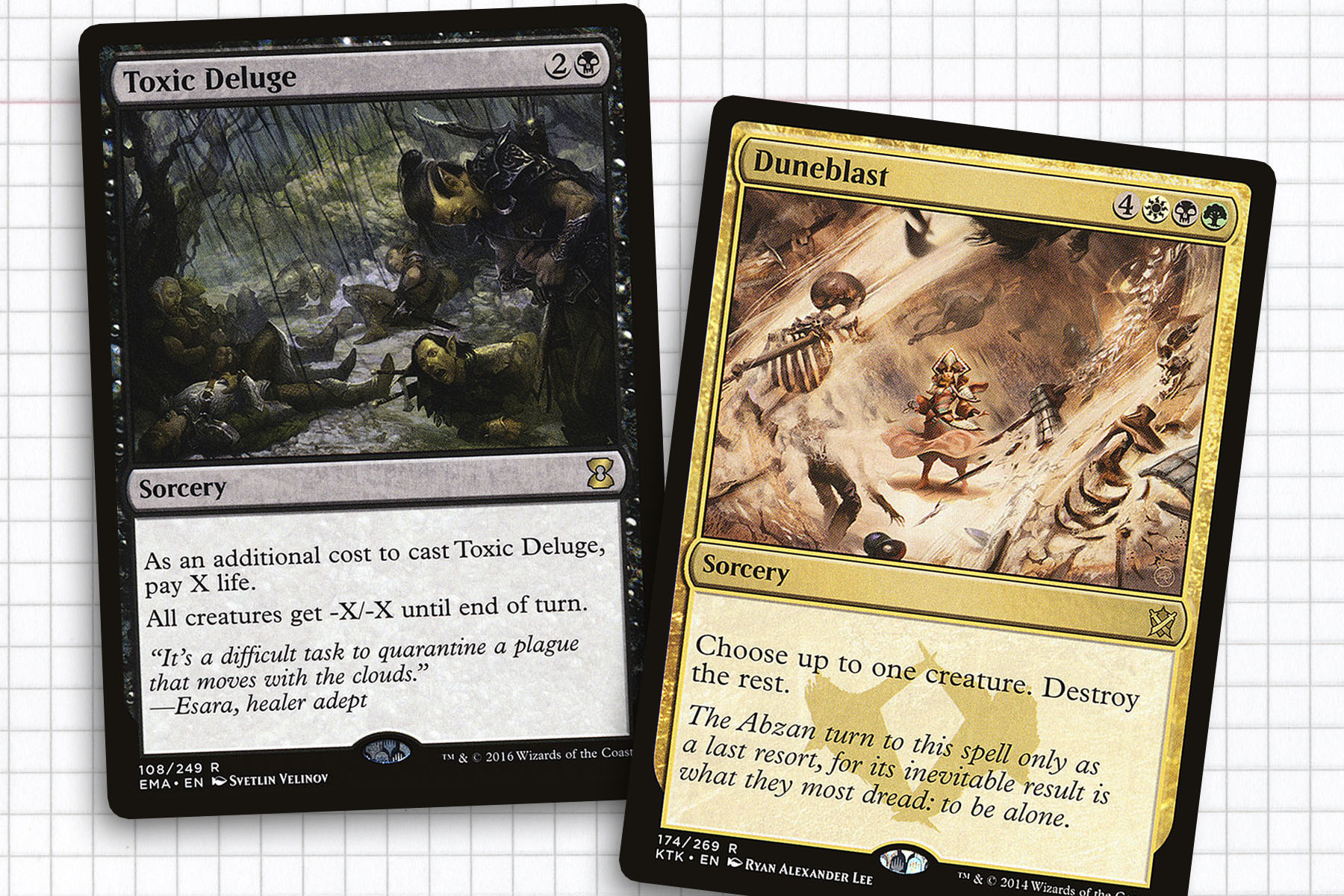
Maximizing Removal
Wrath of God and its fraternal twin, Damnation, are not what they used to be. When I first started building this deck I had things like Day of Judgment and the Wrath twins as my mass removal, but soon realized that I needed more niche answers to board states. Enter spells like Hallowed Burial, Duneblast, and Rout to specialize against graveyard decks, Voltron wins, and emergency removal as games demand.
This is the only deck I felt that I needed to add Armageddon to. While I feel that mass land destruction can make games unfun, if it is used as the last nail in the coffin to end a game in the next turn or two, it’s part of your strategy. In four years I have cast it three times, either as a way to stabilize or win.
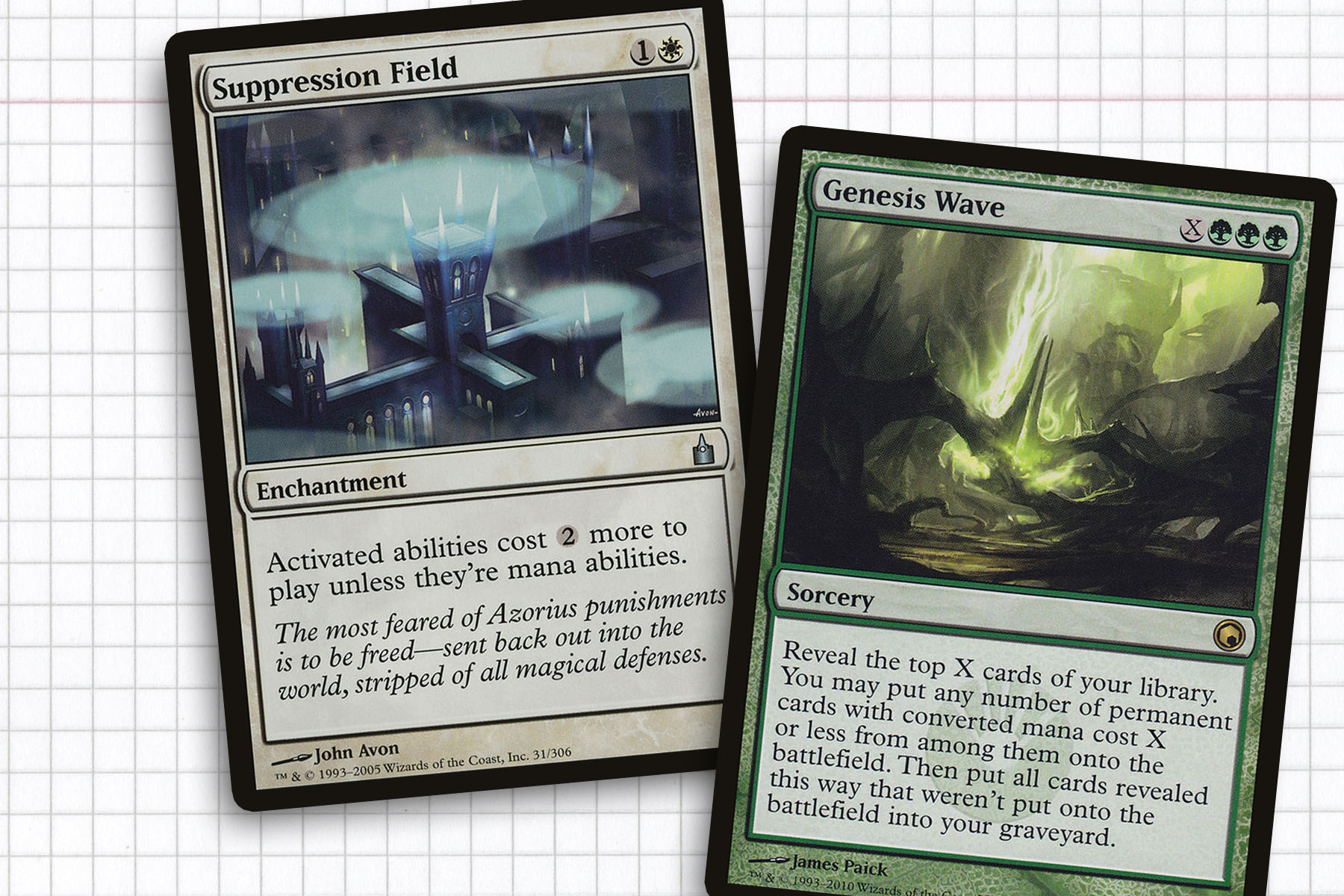
Living on the Edge
There is no question that I have a subjective viewpoint of this deck. Part of what makes it so good is how it was tuned for the different Minnesota metagames and how it plays games in a style that I enjoy personally. Not only does this deck employ a relatively cheap general who can easily be a three turn clock to remove someone from the game, but when that plan doesn’t work out it has the capacity to maintain relevance deeper into the game. I may not win every game—the deck isn’t unstoppable—but with a mixture of Greed, Mind’s Eye and the Demonic Tutor, I can often find answers to established engines, opposing Wraths effects, and problematic generals.
Suppression Field and Suncleanser are two recent toolbox additions to help combat the perceived or present threats of marquee Commander product generals like Lord Windgrace and Meren of Clan Nel Toth, which dominate games where someone doesn’t have an answer. Genesis Wave is often the best card to rebuild after board wipe, resetting my board while others may be confined to two or three spells a turn. And I employ Lignify and Darksteel Mutation as cheap ways to halt the progress of decks that are relying on their general to assemble an easy win.
I love this deck for its ability to stay resilient game after game and also keep me feeling like a back-up plan is just a draw step away. Some of my decks can haphazardly overextend without meaning to or devolve into a series of triggers that leave me comatose to a game plan. Not with Doran—I always have to be mindful of the game and keep assessing my options. I adore the deck for that. I hope you have a deck that really speaks to you, whether it be a home brew or packaged product that really spoke to your sensibilities.
Ryan Sainio is a Graphic Designer who writes about EDH, the EDH community, and streams on Twitch in his down time. He has been playing Magic: The Gathering since 7th Edition in 2002 and values flavorful and fun gameplay over competitively optimized decks. Join him for a stream at twitch.tv/hipstersainio on Tuesday nights.

